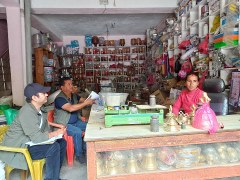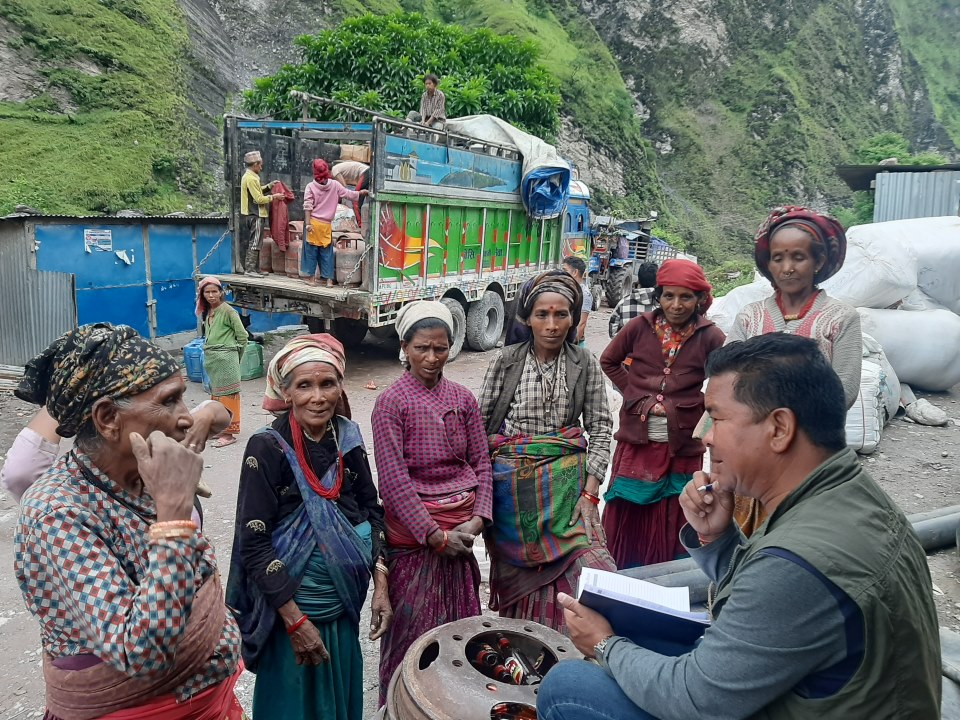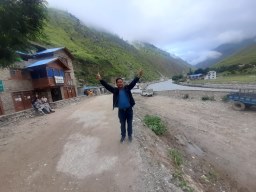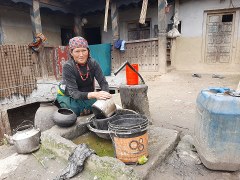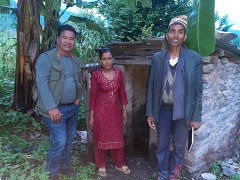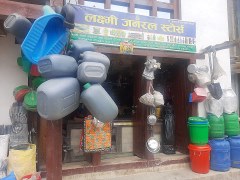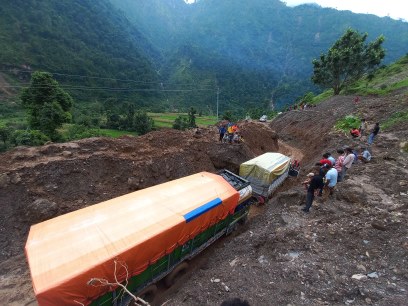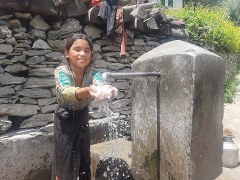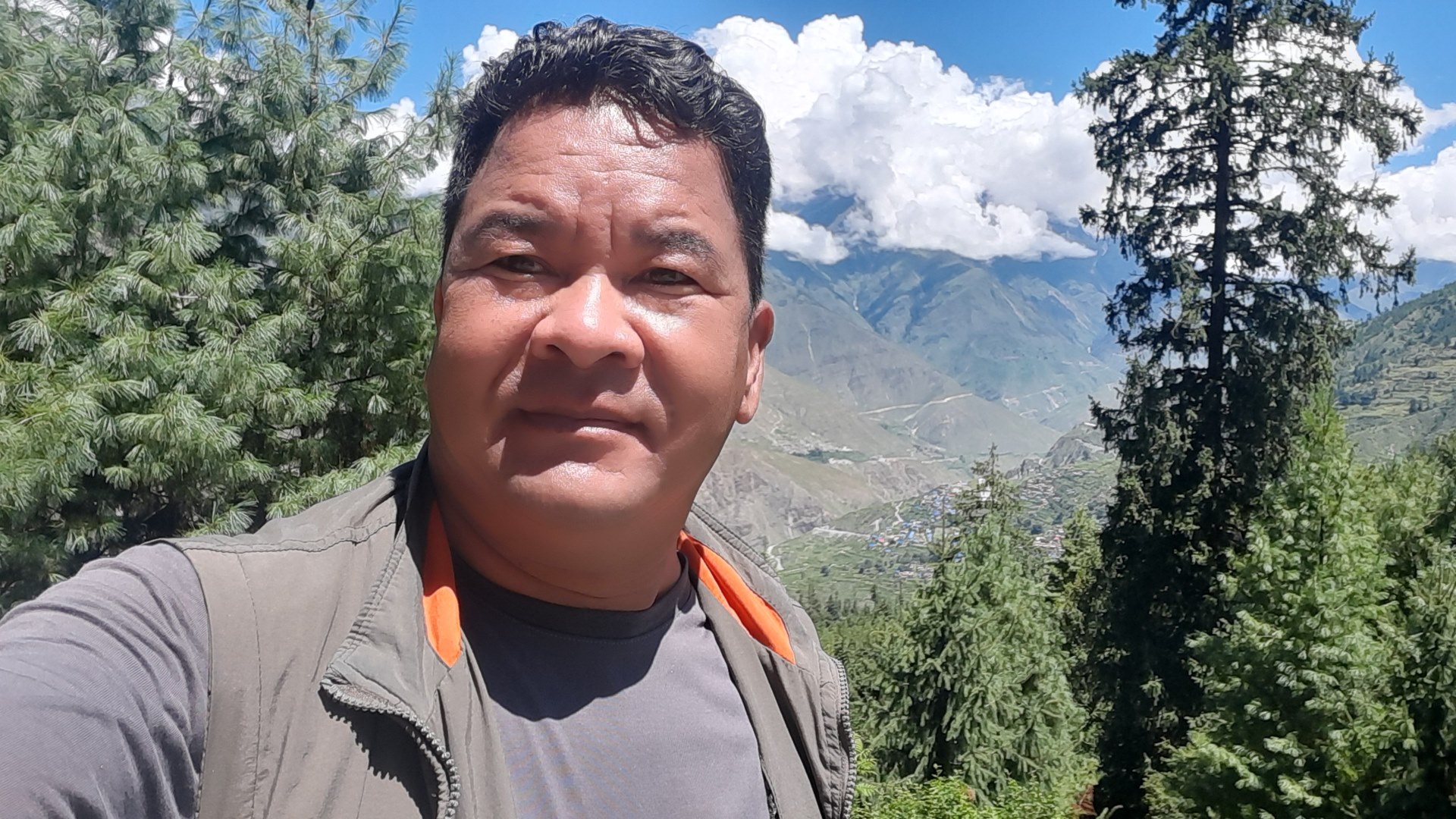
Govinda Rokaya joined SUSWA two months ago as a Sanitation & Hygiene Specialist, with the focus on Sanitation Supply market. Govinda’s family lives in Kathmandu, with one of his sons studying to become an architect and the other studying science in class 12. Govinda’s extended family lives in Dolpa, as he himself is originally from the SUSWA working area. Govinda grew up in Dolpa without access to a toilet and is nowadays a passionate sanitation and hygiene expert. Read more below!
Govinda in the Surkhet office
What does your job as Sanitation & Hygiene Specialist with SUSWA entail?
My job is to facilitate local government and support the SUSWA team to work for improved access to sanitation and hygiene. For this, I will have to facilitate building a shared understanding between local and provincial governments and WASH stakeholders on sanitation and hygiene and support combined efforts for improvement. Obviously, my job relates to GEDSI as well, as those more disadvantaged may be the same ones who are not reached or who don’t have access to sanitation facilities and to practice hygiene.
And I am very confident due to my knowledge and experience in working for multiple organizations.
Tell me more about your background in Sanitation and Hygiene, how did you become this passionate about it?
My father and mother were illiterate, but I went to school. And turns out, I was really good at school – top SLC (School Leaving Certificate examinations) 1994 in all of, what was then, Karnali. I therefore could continue to do a bachelor in Pokhara and master in Kathmandu in English and Sociology, as well as some courses on sanitation & hygiene. For me, sanitation and hygiene is related to social and cultural, so my degree makes a lot of sense in this sector.
After my studies I started working in my home district Dolpa, for the district development committee, where we began interventions for WASH in the rural areas. Working for SNV, I continued this work also in the districts of Mugu and Jumla. We were very much the pioneers in the work towards declaring Open defecation free areas in what are now Karnali province: all of it was ODF declared by June 2018, 1.5 years ahead of all of Nepal.
Having worked for SNV for 10 years, I went on to work with other agencies as I truly believe it is important to get exposure to different ways of working and doing things to become an expert. I worked for, for example, UN Habitat with Global Sanitation Fund (GSF) for Sanitation and Hygiene promotion in Terai, an area which was very difficult to declare ODF. Over 20% of Nepal’s population lives in 8 districts that now make up Province 2 in the Terai and there were transboundary issues, with India giving subsidies for those who constructed toilets while Nepal was not doing it. But when we succeeded in mobilizing, sensitizing and brining stakeholders together, I was so happy.
After the 2015 earthquake I took part in reconstruction and recovery through leading some projects in WASH and, especially, School WASH, embedding menstruation management and behaviour change as important parts of School WASH programming. When working for Helvetas Nepal and Caritas Switzerland we established 40 schools rated as number 1 in Nepal for their WASH and environment friendly aspects by the Social Welfare Council (SWC) and National Reconstruction Authority (NRA).
Click here to see a video Govinda and his team made about School WASH.
Now I am back in Karnali with SUSWA, as an inhabitant of Karnali, and as a WASH professional of 20 years. There is still some work to do in Karnali, for example aligning with government targets to ensure safely managed the water supply and sanitation and hygiene that are in turn aligned with SDG 6… There is actually still a lot of things to do for improving sanitation and hygiene overall, and, importantly for Karnali, improving livelihoods through WASH as well.
There are challenges but also great opportunity – for the improvement of the lives of the people of Karnali. SUSWA will work in 42 municipalities, which is a very ambitious project. But we should be ambitious! And I myself have a lot of ambition to make it happen, especially because SUSWA is prioritizing the more remote municipalities where others are not working.
Govinda talking to potential beneficaries in SUSWA working area
What is your and SUSWA’s current approach or strategy?
SUSWA’s focus is on improving the supply chain and collaboration mechanisms, e.g., through holding a WASH summit on provincial level, so all newly elected officials will have common knowledge and goal and target for WASH services. Later on, this will facilitate local governments so they have commitment for increasing budget for the WASH sector, for institutional set up of e.g., WASH-Municipal-council, WASH Unit for monitoring, and we will support set up for legal instruments.
Govinda in Dolpa, where he used to play with his friends
What is the current hygiene and sanitation findings of Karnali?
Coming to Karnali now after quite a long time… well, becoming open defecation free (ODF) has been achieved but there is a long way to go to improve sanitation. I recently did a field study with iDE with whom we will partner in the future, and when we look at the sanitation and hygiene situation on the ground, the conditions have not improved. There are also access challenges for people with disabilities and social taboos regarding menstruation.
During the ODF campaign plastic pans were distributed, they have been using them for about a decade, and now when we see them, they need to be replaced. People would prefer ceramic ones – this is a change, people are more aware about options and can compare, however, balancing demand and supply is a problem – not everyone is on the same page. Supply plays a key role. There are currently some shops in the local market with ceramic pans, but they do not know the trend of demand, and for there to be a larger supply and easier access to ceramic pans, more demand needs to be created.
Some of Govinda’s and iDE’s supply chain findings:
The access to toilets is disproportionately distributed from one areas to another.
Through FGDs, KIIs, we can conclude that access to toilets remains at around 85% of households (HH).
Out of the HHs having toilets, the types of the toilets are:
- Fiber pans-80%
- Ceramic-5-10%
- Cemented slope-10%
Out of 85% of HHs having toilets, some don’t use the toilets due to not having water, toilets being damaged, toilets being so low, narrow etc.
The causes of not having toilets in some households:
- Poverty
- Lack of market
- Lack of motivation
- Lack of regulations and enforcements
The hygiene part is the weakest throughout and needs serious and due attentions, without which communities can not get the benefits of water supply and sanitation, such as improved health condition, economic benefits and social dignity.
There is combined business model: WASH products and materials are sold along with other hardware materials. The cost of ceramic toilet pan in Dunai is around NPR 4000 and is usually not available and brought upon request. The condition of the road to Dolpa is not good and suppliers don’t prefer to carry ceramic items including the toilet pans as loading the trucks and unloading increases the costs. It is likely that there will be direct access of roads to Dolpa within a years time from now, if the bridge is constructed over the Bheri river at Tallu of Jajarkot, and this will ensure direct access to road for 8-9 months as there are other streams which would require bridges to cross during the rainy season as well. The access to road will have direct impact on the cost of the WASH materials. The easier the road condition, the lower will be price of the WASH materials and the improvement of the toilets will betake momentum.
Further, there is need to raise awareness, creating demand for improved sanitation and hygiene and in turn having an impact on the supply chain.
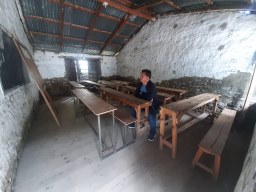
Coming from Upper Karnali, what was the sanitation and hygiene situation in your village when growing up?
Nobody had toilets when growing up. Up to grade 7 and 8 there were no toilets in households, the whole village would wake up early in the morning to walk far away for defecation. This was time consuming, there was shame and disgust, as we used to see each other defecating.
Later, when studying in school, we realized the importance of toilets. But there were no pans to be bought at the market, there was no supply. The first two pans in the village were actually flown in by me from Nepalgunj, when I brought them on the plane. It was also very difficult for villagers to construct the toilets. Construction does not take long, 2-3 days, but it was not prioritized. Sensitization and mobilization is very important, later there was a mass mobilization campaign and it worked.
Now there are toilets in every village – but now we can go further, we have to keep climbing the ladder of sanitation and go further, until there is improved sanitation for all. This will take all our efforts to facilitate. As a local from Dolpa, there are a lot of expectations on me and this motivates me to work for Karnali and Dolpa!
Dolpa-Rukum shots by Govinda
Dolpa-Rukum shots by Govinda
Dolpa-Rukum shots by Govinda
Dolpa-Rukum shots by Govinda
Dolpa-Rukum shots by Govinda
